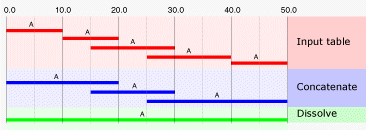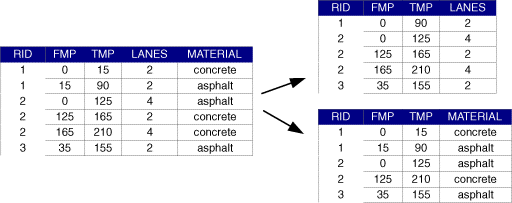You aggregate existing event data using concatenate and dissolve operations. These operations are designed to help maintain the integrity of large event tables.
Both the concatenate and dissolve operations combine event records in tables where there are events on the same route that have the same value for specified fields. The result is written to a new event table. One difference between the two operations is that concatenating will only combine events in situations where the to-measure of one event matches the from-measure of the next event. Dissolving will combine events when there is measure overlap. Another difference is that the concatenate operation is available for both line and point event tables, and the dissolve operation is available only on line event tables.
Learn more about dissolving or concatenating route events

You can concatenate or dissolve to remove redundant information from an event table. For example, if one linear event in a pavement event table has an attribute—concrete—from 0 to 100, and the following event record has an attribute—concrete—from 100 to 125, the two events will be merged into a single event from 0 to 125. Getting rid of redundant event information makes all subsequent operations on the events more efficient.

Another use for the concatenate or dissolve operation is to break up event tables having more than one descriptive attribute into separate tables. For example, if a pavement event table has fields LANES and MATERIAL, the event table can be subdivided into two tables: one having the attribute LANES, the other having the attribute MATERIAL. To do this, the dissolve or concatenate process would need to be run twice.
